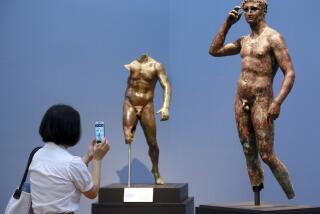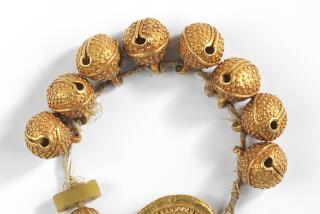Artistic Dispute Seems Set in Stone
LONDON — Nearly two centuries ago, a British ambassador to Greece removed a set of marble sculptures from the Parthenon in Athens. Claiming smugly that the debased modern Greeks were not up to looking after the heritage of their classical forebears, Lord Elgin shipped the marbles home to enjoy the full protection of the British Empire.
But now, to Britain’s embarrassment, it appears that the British Museum in London--where the Elgin Marbles have been lodged since 1816--has not looked after the Greek treasures very well after all.
Museum curators caused irreparable damage to the 2,500-year-old marbles by scrubbing them with metal scrapers in the mistaken belief that they should be white to appear more authentic. The statues’ original paint and patina were removed in 1938 under orders from millionaire art patron Lord Duveen. The misguided project was halted after 18 months, when museum director John Forsdyke inspected the work and the extent of the damage became clear. An internal museum inquiry began.
According to art expert William St. Clair, who next week will publish new research on the botched conservation operation, a government cover-up was organized and all evidence from the inquiry suppressed for nearly six decades.
Worse, St. Clair says in his book, “Lord Elgin and the Marbles,” was the aesthetic cover-up that followed: Some of the marble sculptures were hastily recolored with stained wax to mask the damage.
The revelations have reawakened a rumbling squabble over the future of the Elgin Marbles--and the rights and wrongs of cultural imperialism--that has divided Britain and Greece ever since Lord Elgin sold the statues to the British Museum.
Greece wants the marble pieces back. The new evidence that Britain has mistreated what Greeks call the Parthenon Marbles has only made them more determined.
“The restitution of the Parthenon Marbles constitutes a steady and permanent goal of Greece’s cultural policy,” Vassilis Zafiropoulos, Greece’s ambassador to Britain, said this week.
The Greek Embassy called the episode “shameful,” saying it undermined Britain’s “moral authority” for keeping the marbles. Britain has until now refused to contemplate giving back the sculptures, part of a 524-foot frieze from 5 BC that depicts a procession in honor of the goddess Athena.
Even modern British arguments have an imperial flavor. In 1995, noted art critic Brian Sewell of the Evening Standard said the marbles should not be returned to the Greeks, a “mongrel race . . . superstition-ridden, its stock corrupted by Saracens, Sicilians, Normans, Bulgars, Venetians, Turks and any old Levantine.”
The Greeks had hoped last year that Britain’s newly elected Labor Party government would be more pliant than its Conservative predecessor, but National Heritage Minister Chris Smith quickly ruled out any deal.
Last week, before the current scandal broke, Smith said: “The marbles have been kept in very good condition. Very great care has been taken of them.”
Britain’s reluctance to change course was summed up in a defiant editorial in the conservative Daily Telegraph newspaper.
“Priceless archeological evidence may have been lost. Woe, woe, woe, sings the chorus,” it said this week. “His [Lord Duveen’s] action, in retrospect, was regrettable. But it makes no difference to the British Museum’s right of possession. For the ownership of the marbles was never based, legally or morally, on standards of stewardship--and it is, in any case, impossible to judge how the relics would have fared in Greece.”
More to Read
The biggest entertainment stories
Get our big stories about Hollywood, film, television, music, arts, culture and more right in your inbox as soon as they publish.
You may occasionally receive promotional content from the Los Angeles Times.










